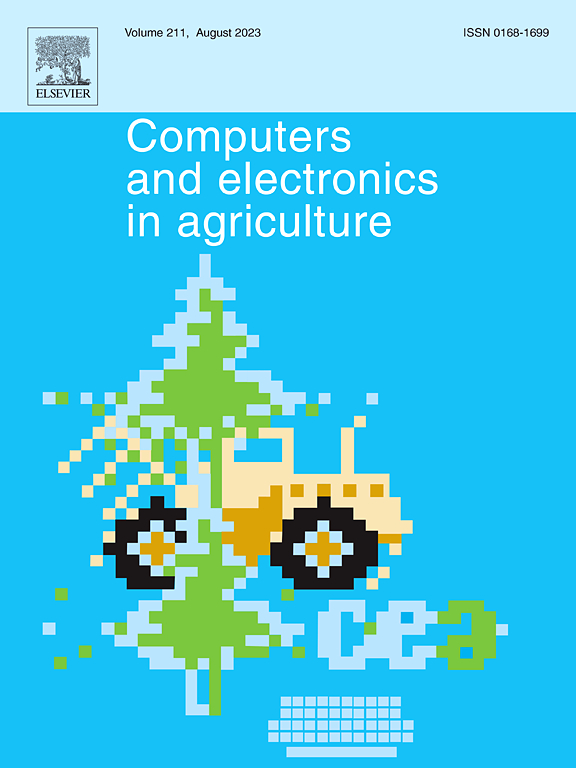Individual tree branch and leaf metrics extraction in dense plantation scenario through the fusion of drone and terrestrial LiDAR
IF 7.7
1区 农林科学
Q1 AGRICULTURE, MULTIDISCIPLINARY
引用次数: 0
Abstract
In forest ecosystems, branch and leaf structures play crucial roles in hydrological and vegetative physiology. However, accurately characterizing branch and leaf structures in dense forest scenarios is challenging, limiting our understanding of how branch and leaf structures affect processes such as interception loss, stemflow, and throughfall. Both terrestrial and drone LiDAR technologies have demonstrated impressive performances in providing detailed insights into forest structures from different perspectives. By leveraging the fusion of point clouds, we classified the leaf and branch of three Japanese cypress trees. Leaf points occupied voxel space was calculated using voxelization, visible branches were fitted using line segments, and the angles and lengths of the invisible branches within the canopy were estimated using the tree-form coefficient. The quantitative analysis results showed that leaf points occupied voxel space at the single-tree and plot scales average were 0.89 ± 0.42 m3/m2. Then, 82, 53, and 58 visible branches were fitted and 23, 14, and 12 invisible branches were estimated for the three trees, respectively. Destructive harvesting was conducted on a single tree to assess the accuracy of branch identification and parameter extraction at the individual branch level. The results yielded an of 0.76 for branch identification and nRMSEs of 32.14 % for branch length and 13.68 % for branch angle, respectively. Our method solves the problem of extracting the branch and leaf structures of single trees in dense forest scenarios with heavy occlusion. The reconstructed tree model can be further applied to estimate tree attributes and canopy hydrology simulations accurately.
基于无人机与地面激光雷达融合的密集人工林场景下单株枝叶指标提取
在森林生态系统中,枝叶结构在水文和营养生理中起着至关重要的作用。然而,准确表征茂密森林情景中的树枝和叶子结构是具有挑战性的,这限制了我们对树枝和叶子结构如何影响截流损失、茎流和通流等过程的理解。地面和无人机激光雷达技术在提供从不同角度详细了解森林结构方面都表现出了令人印象深刻的表现。利用点云的融合,我们对三棵日本柏树的叶子和树枝进行了分类。利用体素化计算占体素空间的叶点,利用线段拟合可见树枝,利用树形系数估计冠层内不可见树枝的角度和长度。定量分析结果表明,在单树和样地尺度上,叶点平均占用体素空间为0.89±0.42 m3/m2。然后,三棵树分别拟合了82、53和58个可见分支,估计了23、14和12个不可见分支。在单树上进行破坏性采伐,以评估单个分支水平的分支识别和参数提取的准确性。结果表明,分枝识别的f1得分为0.76,分枝长度和分枝角度的nrmse分别为32.14%和13.68%。该方法解决了茂密森林场景下单树枝叶结构的提取问题。重建的树木模型可进一步用于准确估计树木属性和冠层水文模拟。
本文章由计算机程序翻译,如有差异,请以英文原文为准。
求助全文
约1分钟内获得全文
求助全文
来源期刊

Computers and Electronics in Agriculture
工程技术-计算机:跨学科应用
CiteScore
15.30
自引率
14.50%
发文量
800
审稿时长
62 days
期刊介绍:
Computers and Electronics in Agriculture provides international coverage of advancements in computer hardware, software, electronic instrumentation, and control systems applied to agricultural challenges. Encompassing agronomy, horticulture, forestry, aquaculture, and animal farming, the journal publishes original papers, reviews, and applications notes. It explores the use of computers and electronics in plant or animal agricultural production, covering topics like agricultural soils, water, pests, controlled environments, and waste. The scope extends to on-farm post-harvest operations and relevant technologies, including artificial intelligence, sensors, machine vision, robotics, networking, and simulation modeling. Its companion journal, Smart Agricultural Technology, continues the focus on smart applications in production agriculture.
 求助内容:
求助内容: 应助结果提醒方式:
应助结果提醒方式:


